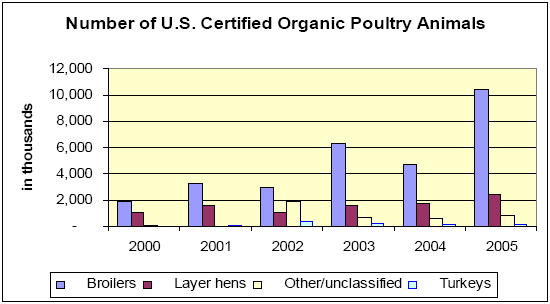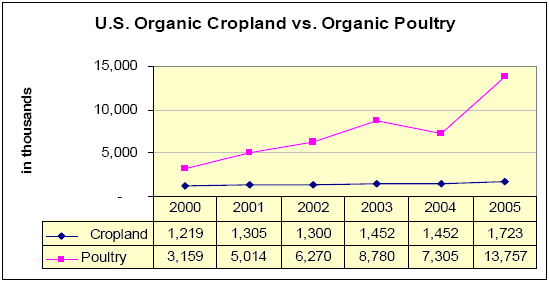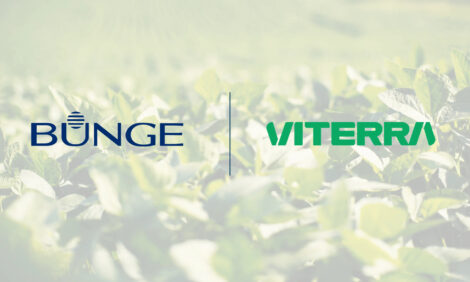



International Egg and Poultry Review
By the USDA's Agricultural Marketing Service - This is a weekly report looking at international developments concerning the poultry industry.Organic Poultry
World interest in organic farming has been rapidly growing for almost two decades and organic farming is practiced in over 100 countries. In 1999, the Codex Alimentarius Commission endorsed the Guidelines for Organically Produced Foods and FAO started its Organic Agriculture Program the same year. As of February 2006, 43 countries had operational regulations on organic agriculture and 16 other countries had programs in various stages of development.
In 2003, EU-15 certified broilers and layers were over 9 million and 6 million respectively. France ranked first with 5.1 million broilers; the UK was second with 1.4 million broilers. France had 1.3 million laying hens. The farm gate premium for organic eggs averaged 132%, and ranged from 25% in Austria to 329% in Greece. In 2002 in Austria, only 6.6% of all eggs sold were organic. For the first four months of 2005 this share climbed to 16.5%. For January-April 2005, the average price per kilogram in Euros was 4.20, up 12.4% from the same period a year earlier and 57.7 % higher than the price of conventional eggs.
Eggs and poultry are now the fastest growing organic food products in the U.S., despite high costs and shortages of organic feed grains and other challenges in production and marketing. Organic poultry and egg sales are less than one percent of total sales, but organic egg sales are expected to increase nearly 40 percent and poultry sales to more than triple by the end of the decade.

Certified organic poultry meat nearly quadrupled in the U.S. between 2000 and 2005, to over 13 million certified birds. Even with the increase in production, the limited supplies compared to the growing demand resulted in average price premiums to first receivers (retailers, distributors, manufacturers) of 200 percent for organic broilers and 278 percent for organic eggs.

Production costs are also higher for organic eggs and poultry. Organic feed typically costs 50 to 100 percent more than conventional feed, and accounts for up to 70 percent of the cost of raising organic chickens. Increasing demand and unfavorable growing conditions recently resulted in some shortages and even higher prices for organic grain and soybeans in the U.S.

Source: Food and Agriculture Organization of the United Nations; International Task Force on Harmonization and Equivalence in Organic Agriculture; USDA Foreign Agricultural Services; European Commission; USDA Economic Research Service; Stiftung Ökologie & Landbau (SÖL) - Foundation Ecology & Agriculture
Mexico and NAFTA
The North American Free Trade Agreement, which began in 1994, will reach full implementation in 2008. Next year, restrictions placed on U.S. poultry exports to Mexico will be eliminated. Mexican producers are braced for stiffer competition, especially with the current high corn prices. Prices in Mexico are considerably higher than U.S. poultry market prices. The National Poultry Growers Union (UNA) will try to focus on exploiting the difference between domestic and imported products, basically a “fresh vs. frozen” competition.
Source: USDA/FAS Attaché Report
Central American Poultry Export Quotas
An export trading company was created to administer CAFTA quotas for chicken leg quarters. The Central America Poultry Export Quota, Inc (CA-PEQ) was created in 2006 and the first two auctions for shipment were held in 2006. On February 27, 2007, the Department of Commerce amended the CA-PEQ Export Trade Certificate of Review to permit publication of the names of firms that have been awarded quota rights in the open-tender auction process.
In January 2007, TRQ certificates were awarded to six companies and in May 2007, TRQ certificates were awarded to three companies. Information is available at http://www.ca-peq.org.

Source: Central America Poultry Export Quota, Inc; Federal Register; USDA Foreign Agricultural Service
To view the full report, including tables, please click here











